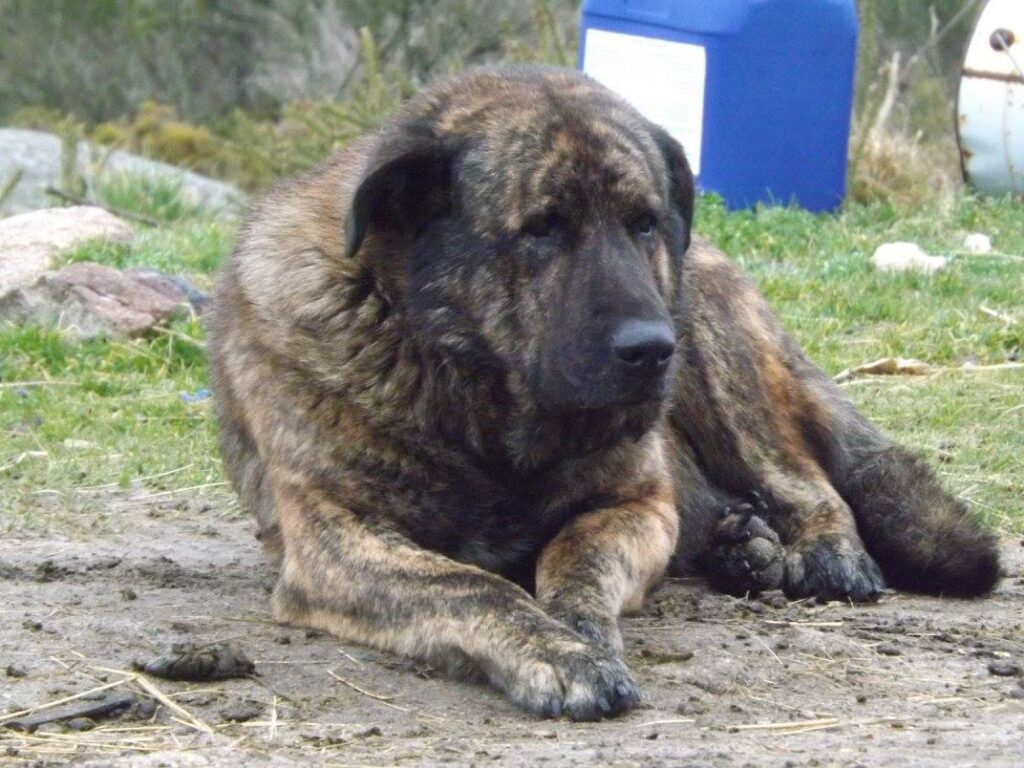
Are you considering adding a Livestock Guardian dog to your farm or ranch? Or perhaps you’ve already welcomed one into your family and are seeking answers to some common queries? We have the answers to the frequently asked questions about Livestock Guardian dogs that you are looking for!
In this comprehensive blog post series, we will answer your frequently asked questions about Livestock Guardian dogs, shedding light on their purpose, traits, training, and care.
Whether you’re an experienced farmer or a curious dog lover, we’re here to provide you with the information you need to better understand these remarkable canine companions and their vital role in protecting livestock
Let’s dive into the world of Livestock Guardian dogs and uncover the answers to the most frequently asked questions about LGDs.
What breed of Livestock Guardian Dog should I get?
The suitability of a livestock guardian dog breed depends on your specific situation and the needs of your livestock.
Breeds like the Great Pyrenees, Maremma, Colorado Mountain Dog and some Transmontano Mastiffs and Estrela Mountain Dogs are more beginner friendly and more likely to tolerate strangers if introduced properly.
If you are looking for a breed that will prevent human predators from accessing your livestock you would want to consider sharper breeds like the CAS, Komondor, Kuvasz, Karakachan or Anatolian Shepherd Dog.
Look for a Livestock guardian dog breeder that is raising puppies from working adults in an environment similar to yours. The right breeder is key to finding the right breed, working style and temperament for you.
Consider your specific circumstances, such as available space and proximity to neighbors, when selecting a livestock guardian dog breed. Click here to learn more about the Livestock Guardian Dog Breeds Available in the United States.
Should I get an older Livestock Guardian Dog or a puppy?
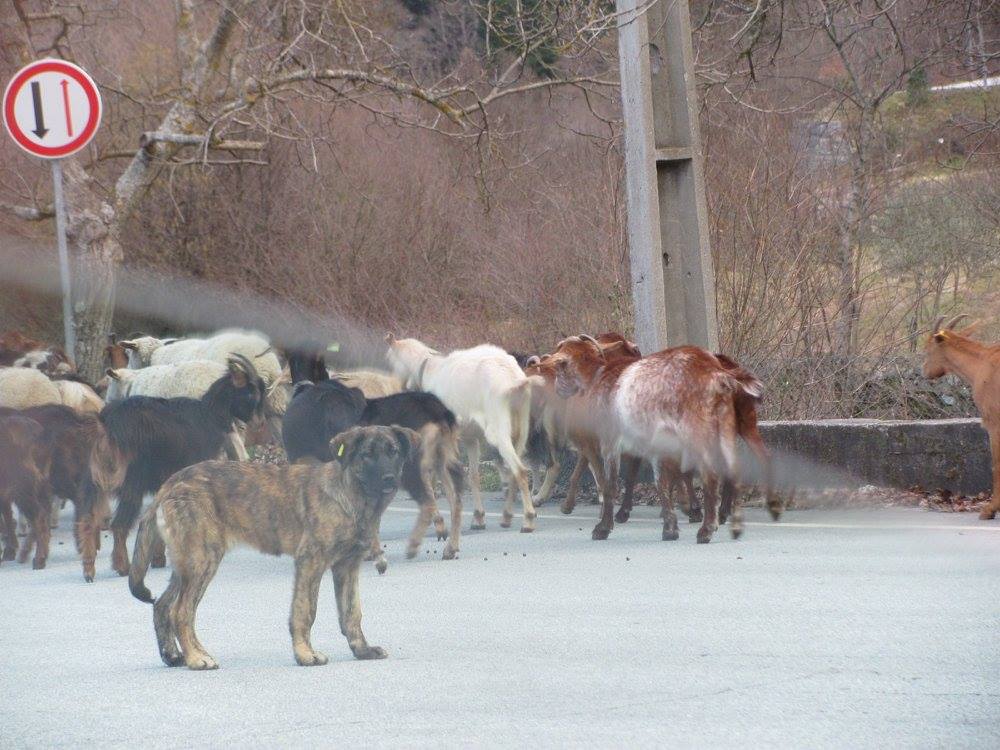
Working, adult livestock guardian dogs are hard to find, because they are doing their job. The downsides of getting an adult dog include the dog possibly having bad habits, and having to readjust to a new setting and new livestock.
On the other hand it takes a while before a puppy is mature enough to do their job, but you are able to shape their behaviors and start them out properly with your expectations.
If you are able to find a working adult, it is worthwhile to acclimate the dog to your farm and livestock, and then add a puppy with it for companionship and as a future working dog. This is a proven strategy that has worked well for many farmers.
How much does a Livestock Guardian Dog Puppy Cost?
Livestock guardian dogs cost between $500-$3000. Price will vary based on breed, pedigree, health testing, parents working ability, and the livestock guardian dog breeder’s reputation.
Yes, you might find cheaper litters of puppies on craigslist. But do you really want to entrust the security of your precious stock to a dog that might not live up to the task in genetics and health? Their are always exceptions, but you often get what you pay for, and livestock guardian dogs are no different.
You can learn more about Livestock Guardian Dog Breeder’s here.
Do you have Estrela Mountain Dog livestock guardian dog puppies for sale?
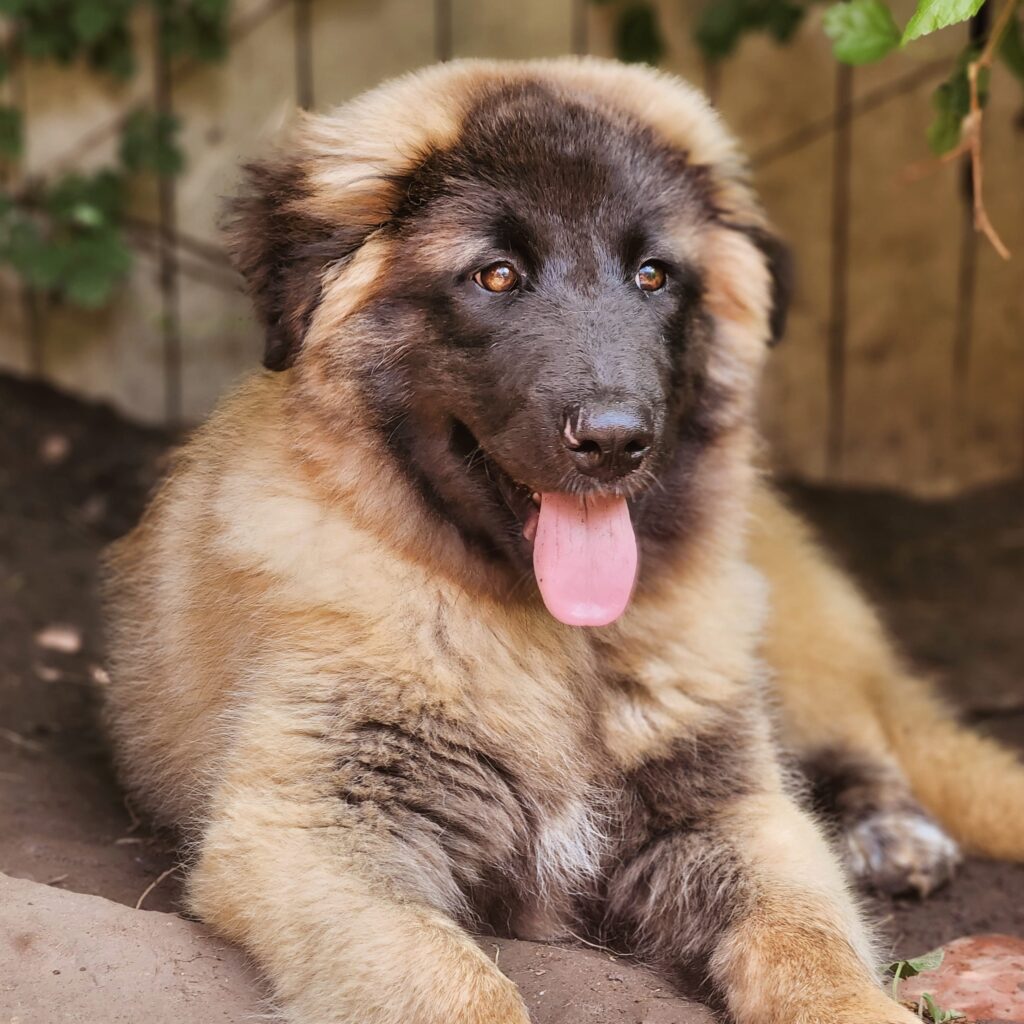
Yes. We have Estrela Mountain dog puppies available for working Livestock Guardian jobs. Our adult Livestock Guardian dogs live with and protect our sheep herds, and poultry.
Do you sell Adult LGDs? Where can I find an Adult LGD?
We occasionally have older, trained Livestock guardian dogs available, but not often. Good adult LGDs are worth their weight in gold and equally hard to find. Your best luck will be to find a trained dog that is needing a new job due to the owner relocating, or selling off their livestock.
How do I train my Livestock Guardian Dog?
Livestock Guardian Dogs need to be trained by encouraging the behavior you want, and discouraging the behavior you do not want. They need to managed, set up for success, and not given the opportunity to fail.
They earn their freedom with livestock, by exhibiting the appropriate calm behavior. If they regress or start chasing and playing with livestock, they need their freedom curbed.
How do I train my Livestock Guardian Dog with chickens?
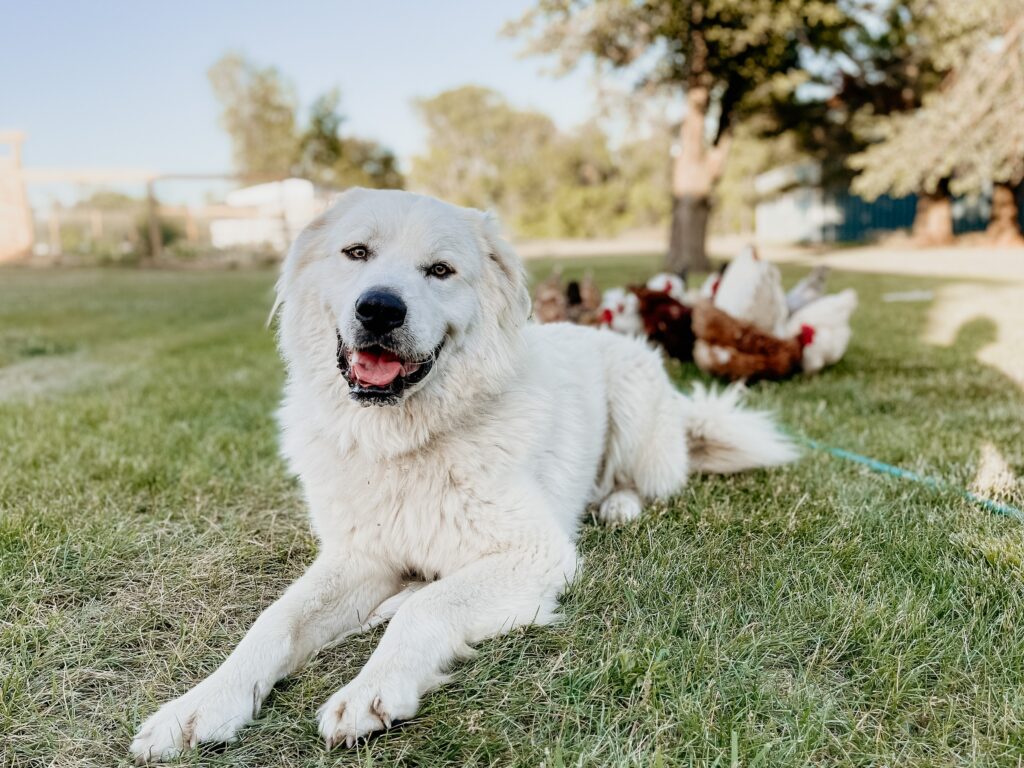
Training your pup to be around chickens takes time and patience.
I always start pups around chickens on leash and they need to see every step. If you let your chickens out to free range they need to see you let them out in order to know its okay they are out.
LGDs can be a little obsessive about things being where they belong so don’t be surprised if a chicken that isn’t allowed out gets caught by your dog. They will accidentally kill them trying to put them back.
So feed your pup. Have a little training session and then go through your chicken chores with the pup on leash. Heavily praise calm quiet behavior and correct any excitement. I will usually refocus them with some basic obedience training.
Next Steps in Training Livestock Guardian Dogs with Chickens
Once the pups are a bit older I will transition to letting the leash drag or putting them on a long line. So I can step on the end if necessary. All chicken interactions should be supervised for at least the first couple of months. Once they are exhibiting calm quiet behavior around the chickens with little to no correction you can tether them near the chickens. With plenty of room for the chickens to escape. Once you are doing this you can gradually start reducing supervision of the dog.
Once they have reached the point of unsupervised on tether then you transition to supervision Off tether and based on the dogs behavior take a step back or start reducing supervision to the point they are off tether and unsupervised.
There may be mistakes made. And if that happens show the dog you are upset and take a step or two back in training to reinforce the good behavior.
Do Livestock Guardian Dogs bark a lot?
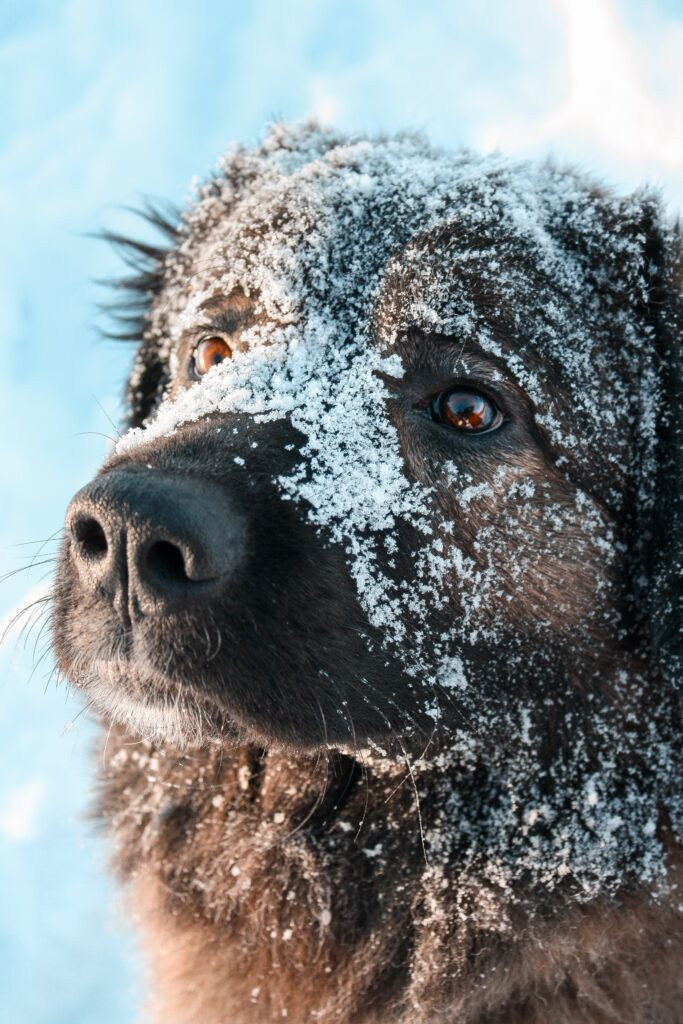
Yes, they can, and will bark. Barking is often associated with Livestock Guardian dogs, and it is one of their defense characteristics. But unnecessary boredom barking is quite simply, unnecessary. And yes, it’s true that some LGDs will bark at insignificant things like butterflies, the neighbors cat or falling leaves. But it’s important to recognize that not all dogs exhibit the same level of barking. Stereotypes about constant barking can be misleading, and are not accurate.
In my experience with my Estrela Mountain Dogs, I have noticed that barking behavior can vary among them. The older dogs have learned to only bark when there is a genuine threat, while the younger two are still in the learning phase (one being a 6 month-old puppy who hasn’t started barking much yet). Building a strong bond with my LGDs and spending time with them outside has played a crucial role in shaping their barking habits.
How do I train my Livestock Guardian dog to stop barking?
To help my dogs distinguish between actual threats and everyday occurrences, I respond to their barking by going outside to investigate. This way I can assess the situation and either reassure them that there is nothing to be alarmed about or provide encouragement if there is a legitimate concern. This process of consistent guidance and reinforcement helps them mature and understand what truly warrants barking and what doesn’t.
Although it requires some initial sacrifice of sleep and extra effort, the outcome has been rewarding. Not only do my older LGDs now know when to remain quiet, but they have also learned that I will support and back them up when there is a genuine threat.
It’s important to remember that every dog is unique, and their response to training may vary. What worked for my LGDs may not necessarily apply to all Livestock Guardian dogs. Individual temperaments, personalities, and training methods can influence their behavior. In some cases, employing additional training techniques might be necessary.
Should I get 2 Livestock Guardian Dog Puppies?

You should only get 2 livestock guardian dog puppies if you are able to manage them appropriately and ensure that their temperaments are complimentary. The LGD world is divided on whether buying 2 pups at once is good or bad. And honestly I’ve been more on the bad side.
Not because I believe in “littermate syndrome,” which has yet to be scientifically proven as anything other than mismatched temperaments or codependent bonding with each other instead of their owner. But because most owners are not prepared to manage one puppy properly, and 2 puppies just compound the issue.
There are two different symptoms described, either the littermates fight or they do their own thing and bad behaviors feed off each other.
Anytime you have more than one dog, whether its an LGD or not, you run the risk of mismatched temperaments. This could be two dominant dogs that are constantly fighting over who is in charge or one dog just bullying another in the group. There isn’t a way to train mismatched temperaments into getting along and your pack will never flourish. (This can happen even if you bring in a pup to an existing pack, so it really has little to do with littermates.)
Human responsibility in training 2 LGD puppies
The second reason is most people don’t have the time necessary to devote to separate training and bonding. Seriously one puppy is hard enough. Unless you have a strong existing pack to help and an insane amount of free time two pups is too much for most people. (I’ve done this and it is exhausting, meeting the developmental needs of both puppies equally.)
Another factor that plays in to this decision is age of pack. It is always good to stagger ages in a pack, even if its just by a few months. It really sucks to have your dogs age out of work at the same time. I personally try to stagger ages by 1-2 years.
So I’m not convinced “littermate syndrome” is real, but I am convinced some dogs cannot thrive together. And it would take some work to convince me someone needs and can handle two pups at once. Learn more about How to Find and Buy the Right LGD Puppy Here
What kind of fencing should I use for my Livestock Guardian Dog?
LGDs need a secure fence that keeps them with their livestock and on your property. They often require 4 to 6 foot woven fencing reinforced with electric wire to keep them securely on their owner’s property. Keeping LGDs at home is part of responsible dog ownership. It’s also the law in most areas.
Unless you own thousands of acres you must contain your dogs, and your livestock too. The dogs belong in their pasture with their herds, not in your neighbors yards, and certainly not off patrolling miles away from your property.
How do I keep my Livestock Guardian Dog from Roaming?
Livestock guardian dogs need secure fencing and clear boundaries. Many of the dogs labeled as ‘roaming’ are not actually wandering but patrolling their territory. And they will take as much territory as they can manage. Some breeds are more apt to patrol then others, and dogs within breeds will vary in this regard.
Native shepherds always selected dogs with stock sticky tendencies to work alongside the outer patrol dogs. This gave them the most balanced defense. The patrol dogs would work at deterring predators from ever reaching the herd. If a predator did manage to slip past the patrol dogs, they were met by the interior stock dogs. This team work is a beautiful work of dogs, shepherd and nature.
Often in the United States there is not a need for the patrol dogs, but they should never be eliminated from a breed pool.
If you are looking for a puppy for a smaller acreage, ask the breeder about the adult’s tendencies. It is also helpful to only purchase Livestock guardian dog puppies from proven, working adults, that are working in a situation similar to yours and not roaming.
Can my Livestock Guardian dog bond to other animals?

Yes, the Livestock Guardian dog should learn to protect any animal that belongs to their owner. Will they necessarily bond with them? That depends on the individual breed, dog and circumstance. But they do need to learn to tolerate any species that belongs to their owner and to protect it because it belongs.
What Kind of Shelter should I use for my LGD?
Livestock Guardian dogs need a dry, safe shelter to protect them from the elements, even if they do not choose to use it. Dog igloos, a dry horse stall, barn with the sheep, calf hutches in the field, and built dog houses are all good options.
How many Livestock Guardian Dogs do I need?
The number of Livestock guardian dogs you need will depend on your predator load, the size of your property and the amount of stock you have. I’d also take into account how much stock is getting destroyed in your neighborhood etc. to determine how many you need in future.
An Estimate for how many Livestock Guardian dogs you need:
- 1-2 Livestock Guardian dogs for small predators
- 2-3 Livestock Guardian dogs for non-assertive coyote pressure, and black bears.
- 3-4 Livestock Guardian dogs or more for heavier predator pressure, mountain lions, wolves and large bears.
I have a friend in Western US in the middle of lion country… neighboring farms are loosing sheep left and right, and she has a 2 year old female Anatolian with zero losses under her watch in the last year. Because of the way the owner can bring stock in and lock them up at night, the dog can manage fine on her own, with owner backup if needed. But if it was me, I would run a minimum of 3 dogs for mountain lions.
I like to run an actual pack, and run enough of dogs that I can pull a bitch that has a heat cycle and move dogs around without risking loss to Livestock. More then one LGD is great, but 1 gritty trained LGD is better then a pack of LGDs with bad habits, relationship drama, and stock safety issues.
When should I introduce a Second Livestock Guardian dog?
Once your puppy or adult Livestock Guardian dog is settled in and proven to be stock safe and bonded to the owner, it might be time to add another LGD. LGDs enjoy working in pairs, and enjoy canine companionship.
If you see that your LGD is absolutely exhausted and sleeping all day ( from working all night ) you know that it could be time for backup.
Every situation, farm setup etc. are so different, everyone will have suggestions for what worked for them, but only you will know how much time you want to invest in the near future, or how much time you have to gradually ease into LGD working dogs/ relationships.
When should I spay or neuter my Livestock Guardian dogs?

It’s up to you.
Deciding when to spay or neuter your Livestock Guardian dogs is a personal choice that should consider various factors. If there is a risk of unwanted pregnancies or difficulties in managing intact males and females, spaying before the first heat cycle might be a safer option. However, if there are no immediate concerns, waiting until the dog is at least two years old or after is a recommendation given by many veterinarians.
It’s important to note that recent studies have highlighted a potential link between early neutering and certain health issues such as hip and elbow problems and cancer. These studies suggest that dogs benefit from having their hormones intact during the growth phase until their growth plates have fully developed.
Ultimately, it’s crucial to consult with your veterinarian to discuss the specific needs and considerations for your Livestock Guardian dogs. They can provide personalized advice based on factors such as breed, health history, and individual characteristics. Together with your veterinarian, you can make an informed decision that takes into account the well-being and long-term health of your dogs.
Should I get a male or a female LGD?
Both male and female Livestock guardian dogs make excellent livestock guardians. Females are often more nurturing of young animals, and more alert. Males tend to be more assertive and territorial.
I prefer one of each if the farm requires more then one LGD. Their temperaments are often complimentary, and the pair will work together to protect the flock in a holistic, tactical manner.
Are Livestock Guardian dogs safe with children and elderly humans?

Yes, Livestock guardian dogs should be gentle, loving and protective of children, humans with disabilities, and the elderly. I personally would not trust a dog with my baby animals or stock if it was not trustworthy with humans that needed extra love.
But not all LGDs are trustworthy, many are bred to carry unstable temperaments and are mismanaged. These dogs are not safe with humans, and care and supervision should be used at all times.
Children and puppies alike need to be taught how to honor each other’s needs and boundaries.
Do Livestock Guardian dogs make good pets?
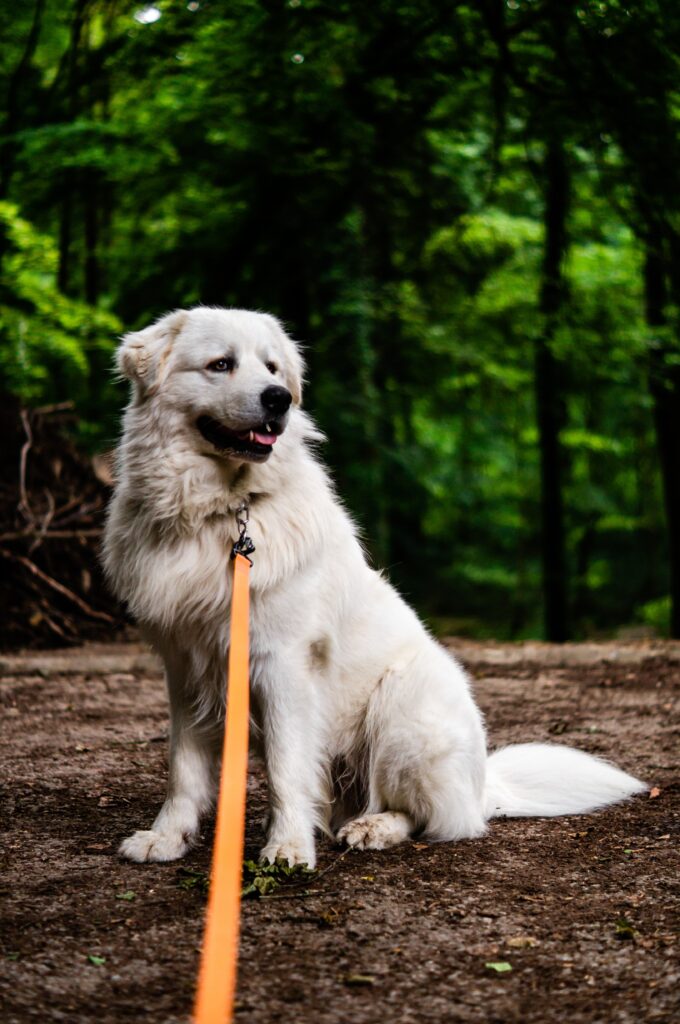
Livestock Guardian dogs can be fantastic pets, if their individual and instinctual breed needs are met, the same as any other dog or breed. Why are we so hung up on LGDs fulfilling a purpose and feeling fulfilled, but we don’t do the same with great Danes, wolf hounds, or poodles?! (Poodles were after all bred to be hunting dogs.)
Breeds like Great Danes, Wolfhounds, and Poodles have diverse backgrounds and were bred for various purposes, yet they are widely accepted as beloved family pets. The same should be true for Livestock Guardian dogs.
LGDs deserve to have their needs honored
Each dog, regardless of breed, has unique characteristics and requirements. Understanding and meeting these needs is crucial to ensure their well-being and happiness. While LGDs have specific instincts and traits associated with their guarding abilities, they can also form deep bonds with their human families and provide companionship and love.
With proper socialization, training, and fulfillment of their mental and physical needs, LGDs can excel as both guardians and devoted pets.
It’s important to challenge the myth that certain breeds are limited to specific roles and to recognize the potential of Livestock Guardian dogs to be wonderful companions and guardians, regardless of their immediate livestock responsibilities.
Every dog deserves a job and human companionship and the opportunity to thrive in a role that suits their individual temperament and abilities.
Do I need a larger or smaller breed of LGD?
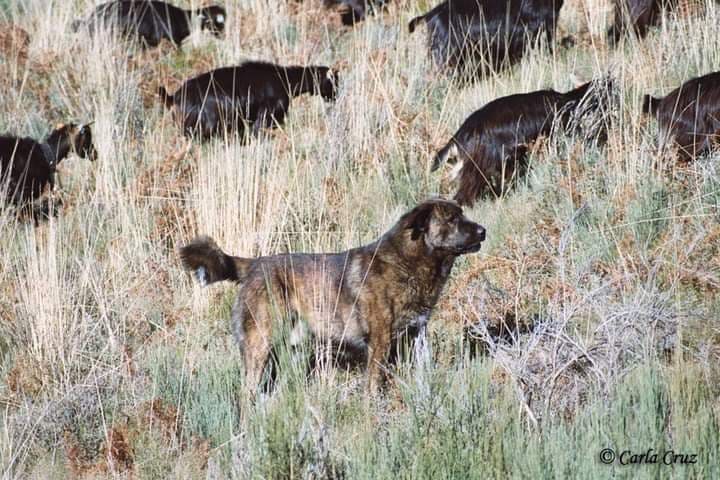
Larger LGDs might be better defense against large predators, but they will also be at risk for more health issues. Smaller LGDs are often healthier, and closer to their landrace roots. Bigger is not always better in the LGD world.
I prefer a dog big enough to back up their grit and still be agile and not clumsy. I also prefer to run a pack with various sizes. A 80 pound female can move circles around larger predators, while a larger male can back her up.
The Facebook posts you see bragging about the “Monster LGD dogs” are a detriment to guardian dogs as a whole. They are often unhealthy, with poor joints and weak hearts. And the breeds used to create this size are fighting dogs, and not guardian dogs. Fighting dogs have poor characters and can be dangerous to stock and even to their owners.
Can My Livestock Guardian Dog help with a birth?
Goal of dogs is to be able to respect the ewe and protect her while birthing not benefit from the birth. Fights can erupt between dogs over birth if allowed to benefit from the birth such as eat the placenta. Hurting mom and baby in process.
Dogs should never interfere with the birth, but allow mom to clean and nurse her baby in peace.
Should I let my Livestock Guardian Dog eat the placenta?
No.
The goat of sheep should have gotten her placentas, or the shepherd. Not the dog.
We never fed them to dogs.
When will my Livestock Guardian Dog be mature?
Ok we have all read or been told that LGDs can’t be trusted until they are 2 years old. Or that at 2 years old they somehow just become perfect.
THERE IS NO MAGIC AGE!
Yes at 2 years old your LGD is going into maturity and will start behaving differently, but I’ve had pups as young as 6 months be 100% stock safe including chickens.
I got that behavior because I did not set my pup up to fail. The pup was never given the chance to learn chasing chickens was fun or that they could play with goats.
Yes temperament and energy levels play a part, but so does brain development. You are literally guiding your pups brain development as you train them. If left to their own devices they will do what is fun, just like any child.
They need play time in a safe area and structured time with stock.
Frequently Asked Questions About Livestock Guardian Dogs Summary
Livestock Guardian dogs play a vital role in maintaining the safety and well-being of our farm animals. And we owe them our animal’s lives over here. They enrich our lives in too many ways to count.
Owning a Livestock Guardian dog is a significant responsibility that requires commitment, patience, and a deep understanding of their needs. By providing them with proper care, training, and a loving environment, you can forge a strong bond with these loyal guardians while ensuring the safety of your precious livestock.
So, whether you’re considering adding one to your team or simply seeking knowledge, we hope this blog post has served as a valuable resource, enabling you to navigate the world of Livestock Guardian dogs with confidence and enthusiasm.
Related Posts You May Like:
Livestock Guardian Dog Breeder
Livestock Guardian Breed Dogs vs Herding Breed Dogs: What’s the Difference?
Comments +